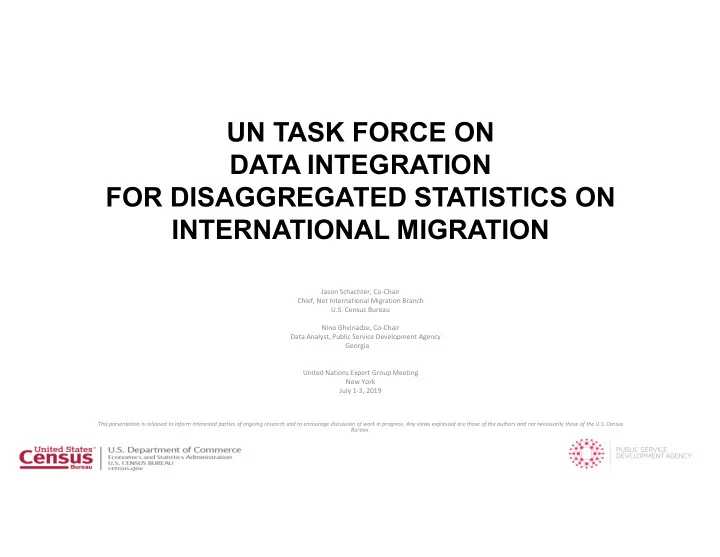

UN TASK FORCE ON DATA INTEGRATION FOR DISAGGREGATED STATISTICS ON INTERNATIONAL MIGRATION Jason Schachter, Co-Chair Chief, Net International Migration Branch U.S. Census Bureau Nino Ghvinadze, Co-Chair Data Analyst, Public Service Development Agency Georgia United Nations Expert Group Meeting New York July 1-3, 2019 This presentation is released to inform interested parties of ongoing research and to encourage discussion of work in progress. Any views expressed are those of the authors and not necessarily those of the U.S. Census Bureau. 1
Task Force Background and Objectives UN Country Consultation identified a need for guidance on data integration, particularly for non-register based countries Objective: advance methodologies to produce data that are sufficiently disaggregated for the measurement of international migration Proposing a UN Task Force on Data Integration with two sub-task forces (1) Macro-data integration Analysis which incorporates results based on data which are aggregates (statistics) of individual-level records (2) Micro-data integration Integration of data based on linkage/matching of individual records Complement, not duplicate, efforts of the 2019 UNECE Task Force on Data Integration 2
Macro-Data Integration Practical applications: methods to produce disaggregated estimates of international migration via the integration of migration statistics derived from multiple data sources Examples: Use different data sources to produce different sub-components of international migration estimates (sometimes referred to as data “compilation”) Adjust migration estimates from one data source using estimates from one or more other data sources (sometimes referred to as data “triangulation”) Combine different data sources to produce migration estimates at different levels of geography (e.g. survey data for national totals/administrative data for sub-national) or by various characteristics of the population (e.g. Bayesian methods to provide estimates for areas/characteristics with scarce observations) Task force will: (a) produce technical materials that provide general guidance on methods to integrate data at the macro level to improve estimates of international migration (b) produce technical materials on macro-data integration for migration statistics 3
Specific U.S. Example Combined different data sources (“big data” and survey data) to produce a final estimate of net migration from Puerto Rico in wake of Hurricane Maria (September 2017) 4
Measuring the Impact of Hurricane Maria on Migration between Puerto Rico and the Mainland United States Source: https://islandsofpuertorico.com/puerto-rico-map/ 5
Net Puerto Rico to U.S. Migration: 2010-2017 Fig. 1 Years 0 Thousands 2010 2011 2012 2013 2014 2015 2016 2017 1-year ACS/PRCS Estimates 50 77,321 100 123,399 Net Migration 150 ACS/APT Blend APT Annual Movements 200 215,166 Feb '17-Jan '18 250 300 301,304 Sources: U.S. Census Bureau ACS/PRCS Estimates and U.S. Bureau of Transportation Statistics - Airline Passenger Traffic (APT) Data 350 ACS/PRCS Net APT APT/ACS-PRCS 6
Micro-Data Integration The second sub-task force would focus on processes needed for successful micro-data integration, particularly for countries without access to population registers Possible topics could include: How to access data from different agencies How to merge data without unique identifiers Methods to validate integrated data and ensure quality control How integrated data could be compiled to follow UN standards and definitions for international migrants TF would not duplicate existing guidelines on data integration, but would complement the prior UNECE Task Force, producing information about procedures and general guidance to set up an integrated microdata system in a country 7
Georgia Example An analytical system to integrate administrative data on micro level to improve immigration data in a broad sense. Administrative data from 9 agencies is collected; Data update and integration happens on regular basis (weekly/monthly); New data sources can be add (integrated to the system) as it develops; Used for immigration trend analysis as BI tool; 10+ test reports produced. 8
Example: short-term (circular) movements in Georgia 2015 & 2016 cohorts observed for 3 years; Cumulative visits from 1 to 6 months in 1-year period; Administrative data sources used: border control, residence permits, nationalization. 9
10
Individual and cumulative lengths of visit; Legal status during the visit. 11
U.S. Example Linking multiple data sources to improve measurement of the subnational distribution of international migrants IDCF (Immigrant Demographic Characteristics File) 12
IDCF Census NUMIDENT IRS 2010 • Age • Geography • Race • Sex • Hispanic origin • Country of Birth *Race and Hispanic origin are imputed for the foreign born who entered after 2010. 13
Percentage Point Difference between Net International Migration (NIM) Estimates and IDCF Data in Hispanic Immigrant Population by County: 2017 Source(s): U.S. Census Bureau 2017 Net International Migration Estimates and IDCF. 14
Task Force Membership Call for member participation The Task Force would consist of two co-chairs to guide work on each respective sub-task force (members can serve on both sub-task forces, or just one, as desired) Task Force members are asked to contribute actively to the work by providing materials on case studies and drafting some parts of the technical materials Work schedule TBD 15
Recommend
More recommend